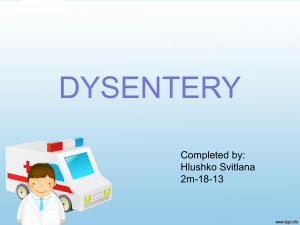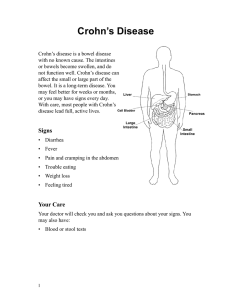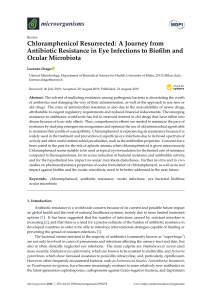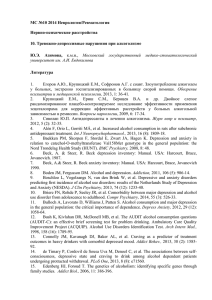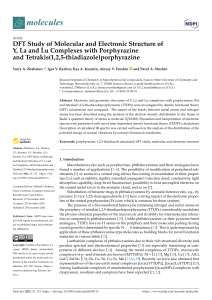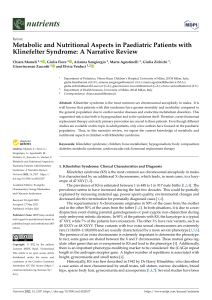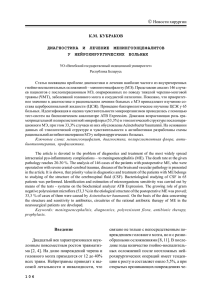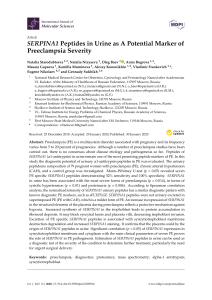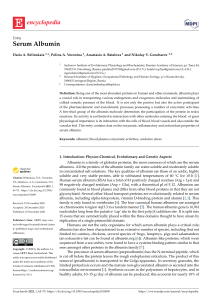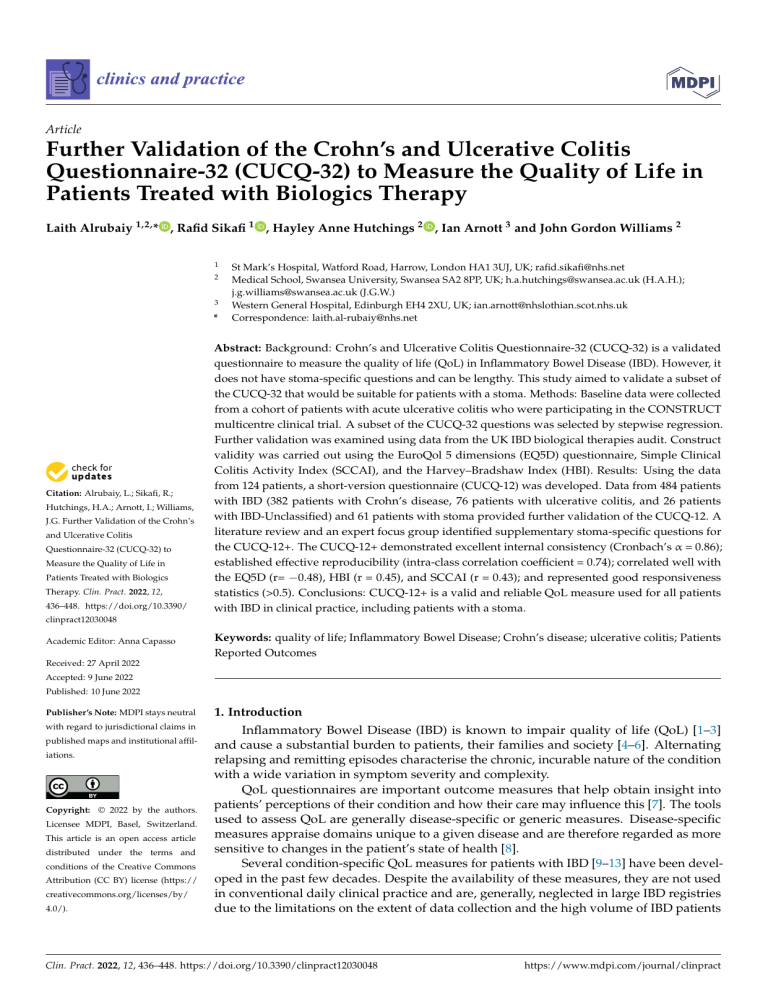
Article Further Validation of the Crohn’s and Ulcerative Colitis Questionnaire-32 (CUCQ-32) to Measure the Quality of Life in Patients Treated with Biologics Therapy Laith Alrubaiy 1,2, * , Rafid Sikafi 1 , Hayley Anne Hutchings 2 , Ian Arnott 3 and John Gordon Williams 2 1 2 3 * Citation: Alrubaiy, L.; Sikafi, R.; Hutchings, H.A.; Arnott, I.; Williams, J.G. Further Validation of the Crohn’s and Ulcerative Colitis Questionnaire-32 (CUCQ-32) to Measure the Quality of Life in Patients Treated with Biologics Therapy. Clin. Pract. 2022, 12, 436–448. https://doi.org/10.3390/ St Mark’s Hospital, Watford Road, Harrow, London HA1 3UJ, UK; [email protected] Medical School, Swansea University, Swansea SA2 8PP, UK; [email protected] (H.A.H.); [email protected] (J.G.W.) Western General Hospital, Edinburgh EH4 2XU, UK; [email protected] Correspondence: [email protected] Abstract: Background: Crohn’s and Ulcerative Colitis Questionnaire-32 (CUCQ-32) is a validated questionnaire to measure the quality of life (QoL) in Inflammatory Bowel Disease (IBD). However, it does not have stoma-specific questions and can be lengthy. This study aimed to validate a subset of the CUCQ-32 that would be suitable for patients with a stoma. Methods: Baseline data were collected from a cohort of patients with acute ulcerative colitis who were participating in the CONSTRUCT multicentre clinical trial. A subset of the CUCQ-32 questions was selected by stepwise regression. Further validation was examined using data from the UK IBD biological therapies audit. Construct validity was carried out using the EuroQol 5 dimensions (EQ5D) questionnaire, Simple Clinical Colitis Activity Index (SCCAI), and the Harvey–Bradshaw Index (HBI). Results: Using the data from 124 patients, a short-version questionnaire (CUCQ-12) was developed. Data from 484 patients with IBD (382 patients with Crohn’s disease, 76 patients with ulcerative colitis, and 26 patients with IBD-Unclassified) and 61 patients with stoma provided further validation of the CUCQ-12. A literature review and an expert focus group identified supplementary stoma-specific questions for the CUCQ-12+. The CUCQ-12+ demonstrated excellent internal consistency (Cronbach’s α = 0.86); established effective reproducibility (intra-class correlation coefficient = 0.74); correlated well with the EQ5D (r= −0.48), HBI (r = 0.45), and SCCAI (r = 0.43); and represented good responsiveness statistics (>0.5). Conclusions: CUCQ-12+ is a valid and reliable QoL measure used for all patients with IBD in clinical practice, including patients with a stoma. clinpract12030048 Academic Editor: Anna Capasso Keywords: quality of life; Inflammatory Bowel Disease; Crohn’s disease; ulcerative colitis; Patients Reported Outcomes Received: 27 April 2022 Accepted: 9 June 2022 Published: 10 June 2022 Publisher’s Note: MDPI stays neutral 1. Introduction with regard to jurisdictional claims in Inflammatory Bowel Disease (IBD) is known to impair quality of life (QoL) [1–3] and cause a substantial burden to patients, their families and society [4–6]. Alternating relapsing and remitting episodes characterise the chronic, incurable nature of the condition with a wide variation in symptom severity and complexity. QoL questionnaires are important outcome measures that help obtain insight into patients’ perceptions of their condition and how their care may influence this [7]. The tools used to assess QoL are generally disease-specific or generic measures. Disease-specific measures appraise domains unique to a given disease and are therefore regarded as more sensitive to changes in the patient’s state of health [8]. Several condition-specific QoL measures for patients with IBD [9–13] have been developed in the past few decades. Despite the availability of these measures, they are not used in conventional daily clinical practice and are, generally, neglected in large IBD registries due to the limitations on the extent of data collection and the high volume of IBD patients published maps and institutional affiliations. Copyright: © 2022 by the authors. Licensee MDPI, Basel, Switzerland. This article is an open access article distributed under the terms and conditions of the Creative Commons Attribution (CC BY) license (https:// creativecommons.org/licenses/by/ 4.0/). Clin. Pract. 2022, 12, 436–448. https://doi.org/10.3390/clinpract12030048 https://www.mdpi.com/journal/clinpract Clin. Pract. 2022, 12 437 looked after in outpatient clinics. Simple-to-use, quick-to-complete, and concise tools could reinforce the routine use of QoL measures in patient care. In severe cases of IBD, patients may need hospitalisation and, on occasion, surgery resulting in a stoma, which may have a negative impact on QoL [14–18]. Although generic QoL measures have been used, they are not specific for patients with a stoma [14,19,20]. Aspects of QoL that are important to patients with a stoma, such as social discomfort and smell, simply have not been included in the current QoL measures [21]. With the emerging new therapies and surgical techniques, a QoL measure in IBD that includes stoma-specific questions is necessary to compare various stoma types, treatments, and interventions in IBD. Studies on patients with a stoma have used generic QoL questionnaires or cancerrelated QoL questionnaires [21–25]. It is essential to mention that none of the currently available QoL measures in IBD has specifically included stoma-related items. The Crohn’s and Ulcerative Colitis Quality of Life Questionnaire-32 (CUCQ-32) is a validated tool to assess the QoL of patients with IBD [26]. However, it contains 32 questions, which some clinicians may perceive to be lengthy for use in routine clinical practice. This study aimed to derive and validate a shorter version of the CUCQ-32 that encompasses the different presentations and severity of IBD, including patients with a stoma. The questionnaire will have as few items as possible to be completed while maintaining its effectiveness through proven validity and reliability on rigorous psychometric testing [27] using data from the UK IBD biological therapies audit. 2. Materials and Methods 2.1. Developing a Shorter Version of the CUCQ The first phase of this study was to derive a shorter version of the CUCQ-32. Baseline data were collected from a cohort of patients with acute ulcerative colitis who were participating in the CONSTRUCT (Infliximab versus ciclosporin for steroid-resistant acute severe ulcerative colitis) multicentre clinical trial [28]. Consented patients from 22 hospitals across the UK were asked to complete the Crohn’s and Ulcerative Colitis Quality of Life Questionnaire-32 (CUCQ-32). Stepwise regression was used to identify the best combination and the minimum number of CUCQ-32 questions required to accurately reflect the total CUCQ-32 score [29,30]. A literature search was carried out to identify the changes and supplementary questions needed to cover patients with a stoma. An expert focus group of two gastroenterologists, two colorectal surgeons, and two outcome measurement experts guided the process. Following the reduction of the CUCQ by stepwise regression, we undertook cognitive interviews and piloted the short version of CUCQ-32 on a group of 20 patients (10 patients with Crohn’s disease (CD) and 10 with ulcerative colitis (UC)) with the stable disease to ensure stable disease that the shortened questionnaire was clear to patients. A semistructured approach using “think aloud” technique was followed to encourage patients to participate and identify items to be included in the stoma-specific questionnaire. The patients were shown the questionnaires at each session and asked to contribute ideas and preferences about the questions’ format, layout and response categories. This was done to ensure the questions addressed all IBD-related issues that are considered necessary by patients and provide feedback regarding the content of the shortened CUCQ and its stoma-specific supplementary questions. 2.2. Validation of the Short Version of CUCQ We used the short version of CUCQ to collect data from patients who received biological therapy for their IBD treatment as part of the UK IBD biological therapies audit. All hospitals from across the UK were invited to participate. The study included patients with diagnosed IBD, ulcerative colitis (UC), Crohn’s disease (CD), and IBD-type unspecified (IBD-U). Patients of all ages were included. Patients were asked to complete the short CUCQ questionnaire and the EuroQol 5 Dimensions (EQ5D) generic QoL measure [20]. The treating IBD specialists were asked to Clin. Pract. 2022, 12 438 fill in a simultaneous assessment of the patient’s current disease activity, using the Harvey– Bradshaw Index (HBI) for CD [31] and Simple Clinical Colitis Activity Index (SCCAI) for UC [32]. Each patient was asked to rate their bowel condition on a scale of 0 to 100 (0 being the worst possible and 100 being the best possible bowel condition). A sub-sample of patients who returned to the clinic for a follow-up appointment was asked to complete the same questionnaires a second time. 2.3. Psychometric Analysis We applied the Statistical Package for Social Sciences (SPSS) version 22 to perform the necessary psychometric testing: Stepwise regression: We used stepwise regression to derive the shorter version of CUCQ by identifying the combination of questions that best predicted the total score of CUCQ [29,30]. Assessing internal consistency: Cronbach’s α was used to evaluate the internal consistency of the short CUCQ. In order to achieve a satisfactory consistency, Cronbach’s α must surpass 0.7 [33]. We eliminated specific questions if their correlation to the total score (item–total correlation) was below 0.2 [27,33] or over 80% of responses were similar (maximum response ratio), due to the low sensitivity of these questions in differentiating between the severity of symptoms [27,33]. Assessing validity: We used one generic QoL measure EuroQol 5 dimensions (which has two components: the 5-item descriptive (EQ5D) and a visual analogue scale (VAS)) as well as two IBD specific tools (SCCAI and HBI) to evaluate the effectiveness of the short CUCQ. To ensure the short CUCQ is an accurate measure of the impact of IBD on a patient’s health, it would need to show a positive correlation (r > 0.4) with QoL measures and disease severity [33,34]. Assessing reproducibility (intra-class correlation): We assessed the reproducibility of the short CUCQ by analysis of a retest questionnaire to a subgroup of patients who came for a follow-up visit after the first completed the short CUCQ questionnaire. In the follow-up questionnaires, we asked patients an anchor question asking about their IBD condition and symptoms on a 100-point scale. To check consistency between the two sets of responses, only patients who reported no change in their bowel condition on the 100-point scale (a change less than 10 points) compared to their first visit were included in the reproducibility analysis. We applied the intra-class correlation coefficient to evaluate the reproducibility of scores for these stable patients [35]. An intra-class correlation between the two sets of questionnaires should surpass 0.70 to reach adequate reproducibility [36]. Assessing responsiveness: We analysed responsiveness in retested patients that revealed a change in their bowel condition on the 100-point scale. We calculated three common responsiveness statistics: effect size, standardised response mean (SRM), and the responsiveness ratio (RR) [35]. The acceptable value for responsiveness ratio is 0.5 or 50% [27–29]. The responsiveness ratio (RR) is the ratio of the mean change in score of patients with improvement or deterioration at the baseline and second assessments to the standard deviation (SD) of scores of the stable group at baseline [35,37,38]. Effect size (ES) is calculated as the mean change in score of patients with improvement or deterioration at the baseline and second assessments divided by the standard deviation of scores at baseline (of the group that had a change in the health status). The standardised response mean (SRM) is calculated by dividing the mean change in scores of patients with improvement or deterioration at the baseline and second assessments by the standard deviation of the differences in scores between the two visits [25]. The SRM differs from ES because the denominator is the SD of change in scores (rather than baseline scores). The effect size value of 0.2 is considered small, 0.5 is medium, and ≥0.8 is large [27]. Defining the minimally important change (MIC): We used the difference in patients’ rating of their bowel condition change in the second visit as an anchor to calculate the MIC. The MIC was the mean change of the scores of patients who reported a difference of less than 10% in their bowel condition on the 100-point scale. Clin. Pract. 2022, 12 439 3. Results 3.1. Development of the Short CUCQ We carried out stepwise regression using the data from 124 patients with ulcerative colitis (UC) who participated in the CONSTRUCT multicentre clinical trial [17] between May and December 2010. Stepwise regression of the 32 questions of CUCQ-32 identified 12 questions that together accounted for 95% of the variance in the total CUCQ-32 scores between patients. The shorter version of CUCQ-32 was called the Crohn’s and Ulcerative Colitis Quality of life questionnaire-12 (CUCQ-12) (Table 1 and Appendix A). The pilot study on 10 patients with stable IBD aged 30–55 y demonstrated clarity of the questions to patients. Table 1. The 32 items of the CUCQ-32 and stoma extension. Rank Questions Ranked by Percentage of Variance in the Total Score That They Explain The Cumulative Percentage of Variance Explained CUCQ-32 items 1. Unable to sleep well 45.9 2. Felt tired 65.9 3. Felt off food 74.0 4. Had to rush to toilet 80.8 5. Bloated abdomen 84.9 6. Toilet immediately after emptying bowel 88.5 7. Noticed blood in stools 90.4 8. Felt generally unwell 91.7 9. Bowels opened accidentally 93.0 10. Toilet to empty bowel after going to bed 93.9 11. Problem with wind 94.8 12. Pain in abdomen 95.4 13. Bowel condition affected leisure 96.2 14. Irritable 96.8 15. Full of energy (reverse coded) 97.4 16. Runny bowel movement 97.8 17. Felt sick 98.5 18. Felt frustrated 98.8 19. Opened bowels > 3 times a day 99.0 20. Felt worried 99.2 21. Avoid events with no toilet at hand 99.5 22. Felt depressed 99.6 23. Sex life affected 99.7 24. Feeling happy (reverse coded) 99.8 25. Felt embarrassed by bowel problem 99.8 26. Prevented from going out socially 99.9 27. Felt angry 99.9 28. Felt the need to keep close to a toilet 99.9 29. Felt upset 100.0 Clin. Pract. 2022, 12 440 Table 1. Cont. Rank Questions Ranked by Percentage of Variance in the Total Score That They Explain The Cumulative Percentage of Variance Explained 30. Felt lack of sympathy from others 100.0 31. Prevented from normal activities 100.0 32. Felt relaxed (reverse coded) 100.0 Stoma supplementary items 1. Feeling less attractive 74.7 2. Problems with stoma care 84.3 3. Afraid others may hear about stoma 91.7 4. Feeling less feminine or masculine 93.8 5. Embarrassed 95.6 6. Worried about leakage 97.2 7. Worried of smell 98.2 8. Dissatisfied with body 99.0 9. Skin irritation 99.7 10. Feeling less complete 100.0 The CUCQ-12 questions addressed the following 12 dimensions: sleep, appetite, energy level, urgency, bloatedness, incomplete emptying of bowels, blood in stool, generally unwell, faecal incontinence, nocturnal diarrhoea, passing flatus, and abdominal pain. The total CUCQ-12 score ranged from 0 (best) to 168 (poor), with each question scored between 0 (best) and 14 (poor). These numbers correspond to the number of days affected by a parameter in a fortnight. To include patients with a stoma, the literature review and the expert focus group identified 10 supplementary questions that were added to the CUCQ-12. These questions (Table 1) covered body and sexual image, stoma function, and skin irritation. The CUCQ-12 questionnaire was called the Crohn’s and Ulcerative Colitis Quality of Life Questionnaire-12 plus (CUCQ-12+). No additional questions were recommended as a result of the pilot study. The mean completion time for CUCQ-12 was 5 min (±3 min). 3.2. Validation of the CUCQ-12+ A total of 507 patients from 181 hospital sites completed the CUCQ-12 questionnaires as part of the UK IBD biological therapies audit between September 2011 and February 2014. We set a cut-off of 9 questions (75%) for the inclusion of individual responses. The data from 23 patients who answered less than 9 questions were excluded from the study. Missing data were replaced by means of the remaining questions scores for each patient. The data from the remaining 484 patients (382 CD, 76 UC, and 26 IBD-U) were analysed. None of the questions were mainly not answered. The spectrum of disease severity and the characteristics of the patients’ sample at baseline are summarised in Tables 2 and 3. Table 2. The characteristics of the patients in stage 2 who completed the baseline CUCQ-12 *. Variable Crohn’s Disease Ulcerative Colitis IBDU Number of cases (n = 484) 382 76 26 <18 5 2 0 18–39 202 41 15 Age Clin. Pract. 2022, 12 441 Table 2. Cont. Variable Crohn’s Disease Ulcerative Colitis IBDU 40–65 141 31 7 >65 34 2 4 Male (%) 160 (42%) 41 (54%) 14 (54%) Female (%) 222 (58%) 35 (46%) 12 (66%) Non IBD co-morbidities 27 2 0 Smoking Current 82 5 2 Never 171 46 16 Ex-smoker 129 25 8 EQ5D utility score 0.65 (0.31) 0.69 (0.25) 0.63 (0.27) EQ5D VAS 48.26 (28.55) 42.03 (30.24) 45.68 (27.56) Gender Generic QoL Had a postgraduate degree or qualification Yes 104 28 12 No 278 48 14 4.88 (4.02) 4.92 (3.97) Disease severity HBI 5.19 (4.86) SCCAI * Categorical data are presented as numbers (percentages). Continuous data are presented as means (standard deviation). EQ5D: EuroQol 5 dimensions (EQ5D) questionnaire. VAS: Visual Analogue Scale. HBI: Harvey– Bradshaw Index. SCCAI: Simple Clinical Colitis Activity Index. Table 3. The clinical classifications of patients with IBD according to the Montreal classification (50). CD UC IBD-U Proctitis 5 2 Left-sided (distal) colitis 41 14 Extensive (pancolitis) 30 10 Colitis Crohn’s disease 1. Location Ileal 96 Colonic 117 Ileocolonic 80 No location was specified 89 CD Perianal 67 2. Behaviour Fistulating 73 Inflammatory 255 Stricturing 55 CD: Crohn’s Disease, UC: Ulcerative Colitis, IBD-U: Inflammatory Bowel Disease Unclassified. The homogeneity of CUCQ-12 was excellent, with Cronbach’s α equal to 0.864. The correlations of each of the 12 items with the total score exceeded 0.2 (Table 4). Reassur- Clin. Pract. 2022, 12 442 ingly, none of these correlations was greater than 0.8, showing that all items added extra information. In addition, no single response was chosen by more than 80% of patients, showing that all items achieved some discrimination. Using the 15% recommended value for the percentage of patients who scored the highest or the lowest scores [26], there were no ceiling or flooring effects in the CUCQ-12. Table 4. Item total correlations for all the 12 items in CUCQ-12+. Questions Item–Total Correlations 1. On how many days over the last two weeks have you felt generally unwell? 0.79 2. On how many days over the last two weeks have you had to rush to the toilet? 0.76 3. On how many nights in the last two weeks have you had to get up to use the toilet because of your bowel condition after you have gone to bed? 0.67 4. On how many days over the last two weeks have you felt tired? 0.70 5. On how many days over the last two weeks have you wanted to go back to the toilet immediately after you thought you had emptied your bowels? 0.75 6. On how many days over the last two weeks have you felt pain in your abdomen? 0.74 7. On how many days over the last two weeks has your abdomen felt bloated? 0.67 8. On how many nights over the last two weeks have you been unable to sleep well (days if you are a shift worker)? 0.69 9. On how many days in the last two weeks have you noticed blood in your stools? 0.50 10. On how many days over the last two weeks have you felt off your food? 0.59 11. On how many days over the last two weeks, have you had a problem with large amounts of wind? 0.60 12. On how many days over the last two weeks have your bowels opened accidentally? 0.52 Stoma supplementary questions 1. In the last two weeks have you felt less attractive as a result of your stoma? 0.80 2. On how many days over the last two weeks have you had problems with care for your stoma? 0.34 3. On how many days over the last two weeks have you been afraid that other people might hear about your stoma? 0.64 4. In the last two weeks, have you felt less feminine/masculine as a result of your stoma? 0.74 5. In the last two weeks, have you felt embarrassed because of your stoma? 0.80 CUCQ-12 had significant (p < 0.05) and demonstrated good correlations with generic QoL measures EQ5D (r = −0.48) and VAS (−0.39). Correlation was also good at disease- Clin. Pract. 2022, 12 443 specific levels (r = 0.51 in CD, r = 0.56 in UC) but was slightly low in IBD-U (r = 0.303) with p = 0.151. Correlation with disease severity indices were also good with HBI (r = 0.45) and SCCAI (r = 0.43) (Table 5). Table 5. Pearson correlation coefficient between CUCQ-12 and with other measures. Correlation of CUCQ-8 with All Patients HBI Patients with CD 0.45 * SCCAI EQ5D Patients with UC 0.43 * −0.48 * −0.51 * −0.50 * VAS −0.36 * −0.37 * −0.23 * * p value < 0.005. Negative coefficients show that generic measures increase while disease-specific decrease. CD: Crohn’s Disease, UC: Ulcerative Colitis, EQ5D: EuroQol 5 dimensions (EQ5D) questionnaire, VAS: Visual Analogue Scale HBI: Harvey-Bradshaw Index SCCAI: Simple Clinical Colitis Activity Index. A total of 61 patients (60 with CD and 1 with UC) had a stoma and completed the CUCQ-12+. The internal consistency of the supplementary stoma questions was excellent (Cronbach’s α = 0.84). None of the items correlated more than 0.8 or a single response of more than 80%. The supplementary stoma questions moderately correlated with the rest of the CUCQ-12 questions (r = 0.59, p < 0.05). However, we noted a positive but poor correlation of the stoma questions with the generic QoL measures, with EQ5D (r = 0.03) and VAS (r = 0.19). Using stepwise regression analysis, we shortened the 10 supplementary stoma questions to 5 questions that represent more than 95% of the 10 questions variance (Table 1). The final version of the CUCQ-12+ included 12 questions related to IBD and 5 questions that are stoma-specific (Appendix A). A subgroup of 36 patients repeated and returned the CUCQ-12 in their second visit within 1 y (the average return time was 3 m). In the reproducibility analysis, we included 11 patients who reported no change in their bowel condition, demonstrating a good intraclass correlation coefficient of 0.75. The remaining 25 patients who reported changing bowel conditions were included in the responsiveness analysis. The responsiveness statistics for CUCQ-12 were good (RR = 0.52; SRM = 0.51; and the effect size (ES) = 0.57). Using the patients’ change in bowel condition as an anchor, we defined the minimally important change (MIC) of CUCQ-12 as a change of 9 points. 4. Discussion Evaluating QoL in patients with IBD is essential in order to assess patient response to treatment. In the last few decades, there has been a rapid increase in the number of measures to evaluate the QoL in patients with IBD [9–13]. However, these measures were limited to clinical trials and are not being used in routine clinical practice. This is primarily because the questionnaires are lengthy and there are often licensing costs associated with using some of the questionnaires. The CUCQ-32 is a validated measure for use in mild and moderate IBD [26]. CUCQ-32 was a valid and reliable measure for QoL in IBD. However, it contains 32 questions, and its length may affect its routine use in clinical practice. CUCQ-32 was not validated in patients with a stoma. Therefore, this study aimed to determine the feasibility of developing and validating a shorter version of the CUCQ for use in patients with different presentations of IBD, including patients with a stoma. The first stage of the study involved identifying the questions that could be included in a shortened version of the CUCQ. We used data from a cohort of patients with acute UC who participated in the CONSTRUCT clinical trial. The resulting 12-item questionnaire, the CUCQ-12, predicted 95% of the total CUCQ-32 score. The literature review and the expert focus group identified supplementary questions that included patients with a stoma, which covered body and sexual image, stoma function, and skin irritation. The CUCQ-12 questionnaire was called the Crohn’s and Ulcerative Colitis Quality of Life Questionnaire-12 plus (CUCQ-12+). Clin. Pract. 2022, 12 444 In stage two of our study, we assessed the data from the 484 respondents of the CUCQ12 questionnaire that were recruited as part of the UK IBD biological therapies audit [39]. The results demonstrated that CUCQ-12 had good reliability and validity. It displayed excellent internal consistency with a Cronbach’s α value of 0.84, above the 0.70 thresholds proposed by Nunnally [34]. The CUCQ-12 showed good correlations with other QoL measures and disease-specific severity indices. An intra-class correlation coefficient of 0.75 demonstrated satisfactory reproducibility. The good responsiveness ratio, SMR and ES of more than 0.5 suggests that the CUCQ-12 is responsive to changes in patients’ clinical conditions and suitable for longitudinal monitoring of QoL. A change of 9 points in the total CUCQ-12 score was found to be the minimally important change as perceived by patients. A total of 61 patients had a stoma and completed the CUCQ-12+ questionnaire. The results showed that the supplementary stoma questions had a good internal consistency, item-total correlations and correlated well with the CUCQ-12 questions. The stoma-specific questions correlated poorly with the generic QoL measures (EQ5D and VAS). EQ5D and VAS questionnaires do not address any stoma-specific QoL domains, such as body image. Therefore, this poor correlation results from the other generic QoL measures and the CUCQ12 questions. We were able to identify 5 stoma-specific questions that best predict the QoL of patients with a stoma. The sample was not enough to carry out a full test-retest reliability analysis. The CUCQ-32 is a derivative work of the Inflammatory Bowel Disease Questionnaire (IBDQ) [10,40,41], created and owned by McMaster University. Although there is a short version of the McMaster IBDQ (the SIBDQ) [40], the CUCQ-12+ is different in several aspects. The phrasing of the questions in the CUCQ-12+ has been customised for use in the UK. The response options of the CUCQ-12+ were simplified using a combination of close-ended and open 0–14 scores answers. The CUCQ-12+ also includes a question about urgency, which does not exist in the IBDQ-32 [41]. CUCQ-12+ includes supplementary stoma-specific questions. Therefore, the advantage of using the CUCQ-12+ is its simplicity and wide coverage of the symptoms of acute IBD. Transition questions are considered advantageous to other methods in evaluating the QoL by directly addressing patients’ insights of change over time. They were used in several outcome measures studies [41–45]. We assessed responsiveness to change and minimally important change (MIC) using patients’ perceptions of their bowel condition via transition questions. Respondents with no changes in their bowel condition were included in the reproducibility analysis, while respondents with a change were included in the responsiveness and MIC analysis. Our test-retest validation was carried out over an average of a 3-m period. Future research is required to evaluate the reproducibility, responsiveness and MIC of CUCQ-12, using other disease indicators, such as endoscopic evaluation and clinical judgment, over a shorter period of 2–4 w as recommended in the literature [46]. The number of patients required to validate the QoL measures in the literature is lacking. The literature lacks guidance on the number of patients needed to confirm the QoL measures. However, a ratio of 5 or 10 patients per item was suggested [34]. Recent studies suggested that at least 100 patients are sufficient for a validation study [47]. Therefore our sample of 484 patients is more than sufficient to validate the 12 questions of CUCQ-12. However, the number of patients with a stoma was less than 100, which is suboptimal. Further validation is needed to confirm the validity of the supplementary stoma questions. To avoid any possible sampling bias, patients were recruited from 181 hospitals across the UK to ensure a good representation of patients and mirror routine clinical practice. Validation is an ongoing process, and the CUCQ-12+ needs to be validated in a varied demographic and clinical setting. In the meantime, the CUCQ-12 performed well in its present form and showed very good psychometric properties in the current study. The CUCQ-12+, a short QoL tool for patients with IBD, has demonstrated itself as a robust evaluation tool with positive internal reliability, reproducibility, validity, and responsiveness. Compared to current QoL measures, this new tool has proven acceptable Clin. Pract. 2022, 12 445 to patients in the UK, concise and readily applicable in clinical practice. These qualities support the use of CUCQ-12+ in national IBD registries and databases and in audits, such as the UK IBD biological therapies audit [39]. Author Contributions: L.A. contributed to writing the manuscript, designing the questionnaires, data collection, and analysis. R.S. contributed to data analysis and writing of the manuscript. I.A. contributed to recruiting patients, data collection, and all manuscript drafts. H.A.H. and J.G.W. contributed to designing the questionnaires, all drafts of the manuscript and data analysis. All authors have read and agreed to the published version of the manuscript. Funding: This research received no external funding. Institutional Review Board Statement: This study was approved by the South-East Wales Research Ethics Committee (Reference 11/WA/0239). The National Health Service (NHS) code of confidentiality and data protection was adhered to. Informed Consent Statement: Informed consent was obtained from all subjects involved in the study. Data Availability Statement: The data presented in this study are available on request from the corresponding author. Acknowledgments: The Crohn’s and Ulcerative Colitis Questionnaire (CUCQ) is a derivative work of the Inflammatory Bowel Disease Questionnaire (IBDQ), created and owned by McMaster University. CUCQ was used and developed by Swansea University for academic and non-commercial clinical purposes in the National Health Service (NHS). All other uses, modifications, and derivatives, including any translations and e-conversion for the CUCQ and its versions, require written permission from McMaster University by contacting [email protected]. Conflicts of Interest: The authors declare no conflict of interest. Appendix A Crohn’s and Ulcerative Colitis Questionnaire-12 (CUCQ-12) Plus The following questions ask for your views about your bowel problem and how it has affected your life over the last two weeks. Please answer all the questions. If you are unsure about how to answer any question, just give the best answer you can. Do not spend too much time answering, as your first thoughts are likely to be the most accurate. If you do not wish to answer any of these questions, please leave it blank, and complete the details of the question and reason(s) why it was not answered. 1. On how many days in the last two weeks have you noticed blood in your stools? . . . . . . . . . . . . . . . . . . . . . . . . days 2. On how many days over the last two weeks have you felt tired? . . . . . . . . . . . . . . . . . . . . . . . . . days 3. On how many days over the last two weeks have your bowels opened accidentally? . . . . . . . . . . . . . . . . . . . . . . . . .. days 4. On how many days over the last two weeks have you felt generally unwell? . . . . . . . . . . . . . . . . days 5. On how many days over the last two weeks have you felt pain in your abdomen? . . . . . . . . . .. days 6. On how many nights over the last two weeks have you been unable to sleep well (days if you are a shift worker)? . . . . . . . . . . . . . . . . . . . . . nights (or days) 7. How many nights in the last two weeks have you had to get up to use the toilet because of your bowel condition after going to bed? . . . . . . . . . . . . . nights 8. On how many days over the last two weeks have you had a problem with large amounts of wind? . . . . . . . . . . . . . . . . . . . . . .. days 9. How many days have you felt off your food over the last two weeks? . . . . . . . . . . . . . . . .. days 10. How many days have your abdomen felt bloated over the last two weeks? . . . . . . . . . . . . . . . . . . . days Clin. Pract. 2022, 12 446 11. On how many days over the last two weeks have you wanted to go back to the toilet immediately after you thought you had emptied your bowels? . . . . . . . . . . . . . . . . . . . . . days 12. How many days have you had to rush to the toilet over the last two weeks? . . . . . . . . . . . . . days If you did not complete any of these questions, please record the question number(s) below and, if possible, give a reason why it was not completed. Stoma Questions Please answer the following questions only if you have a stoma. These questions ask you about your stoma and how it has affected your life over the last two weeks. Please choose only one answer for each of the questions. If you are unsure how to answer any question, give the best answer. Do not spend too much time answering, as your first thoughts are likely to be the most accurate. 1. In the last two weeks have you felt less attractive as a result of your stoma? 0. 1. 2. 3. No, not at all. Yes, some of the time. Yes, most of the time. Yes, all of the time. 2. On how many days over the last two weeks have you had problems with care for your stoma?..... days 3. On how many days over the last two weeks have you been afraid that other people might hear your stoma? . . . . . . . . . days 4. In the last two weeks, have you felt less feminine/masculine as a result of your stoma? 0. 1. 2. 3. No, not at all. Yes, some of the time. Yes, most of the time. Yes, all of the time. 5. Have you felt embarrassed in the last two weeks because of your stoma? 0. 1. 2. 3. No, not at all. Yes, some of the time. Yes, most of the time. Yes, all of the time. References 1. 2. 3. 4. 5. 6. 7. 8. 9. Tabibian, J.; Moradkhani, A.; Raffals, L.; Beckman, L.; Papadakis, K.; Kane, S. Predictors of health-related quality of life and adherence in crohn’s disease and ulcerative colitis. Inflamm. Bowel Dis. 2013, 19, S67–S68. [CrossRef] Robertson, D.A.; Ray, J.; Diamond, I.; Edwards, J.G. Personality profile and affective state of patients with Inflammatory Bowel Disease. Gut 1989, 30, 623–626. [CrossRef] [PubMed] Maunder, R.G.; Cohen, Z.; McLeod, R.S.; Greenberg, G.R. Effect of intervention in Inflammatory Bowel Disease on health-related quality of life: A critical review. Dis Colon Rectum. 1995, 38, 1147–1161. [CrossRef] [PubMed] Casellas, F.; Arenas, J.I.; Baudet, J.S.; Fábregas, S.; García, N.; Gelabert, J.; Malagelada, J.R. Impairment of health-related quality of life in patients with Inflammatory Bowel Disease: A Spanish multicenter study. Inflamm. Bowel Dis. 2005, 11, 488–496. [CrossRef] [PubMed] Hussain, F.N.; Ajjan, R.A.; Kapur, K.; Moustafa, M.; Riley, S.A. Once versus divided daily dosing with delayed-release mesalazine: A study of tissue drug concentrations and standard pharmacokinetic parameters. Aliment. Pharmacol. Ther. 2001, 15, 53–62. [CrossRef] [PubMed] Kornbluth, A.; Sachar, D.B. Ulcerative colitis practice guidelines in adults: American College of Gastroenterology, Practice Parameters Committee. Am. J. Gastroenterol. 2010, 105, 501–523. [CrossRef] Bowling, A. Measuring Disease; Open University Press: Buckingham, UK, 1995. Patrick, D.L.; Deyo, R.A. Generic and disease-specific measures in assessing health status and quality of life. Med. Care 1989, 27 (Suppl. 3), S217–S232. [CrossRef] Mitchell, A.; Guyatt, G.; Singer, J.; Irvine, E.J.; Goodacre, R.; Tompkins, C.; Wagner, F. Quality of life in patients with Inflammatory Bowel Disease. J. Clin. Gastroenterol. 1988, 10, 306–310. [CrossRef] Clin. Pract. 2022, 12 10. 11. 12. 13. 14. 15. 16. 17. 18. 19. 20. 21. 22. 23. 24. 25. 26. 27. 28. 29. 30. 31. 32. 33. 34. 35. 36. 37. 38. 39. 40. 447 Guyatt, G.; Mitchell, A.; Irvine, E.J.; Singer, J.; Williams, N.; Goodacre, R.; Tompkins, C. A new measure of health status for clinical trials in Inflammatory Bowel Disease. Gastroenterology 1989, 96, 804–810. [CrossRef] Irvine, E.J.; Feagan, B.; Rochon, J.; Archambault, A.; Fedorak, R.N.; Groll, A.; Canadian Crohn’s Relapse Prevention Trial Study Group. Quality of life: A valid and reliable measure of therapeutic efficacy in the treatment of Inflammatory Bowel Disease. Gastroenterology 1994, 106, 287–296. [CrossRef] Drossman, D.A.; Leserman, J.; Li, Z.M.; Mitchell, C.M.; Zagami, E.A.; Patrick, D.L. The rating form of IBD patient concerns: A new measure of health status. Psychosom. Med. 1991, 53, 701–712. [CrossRef] [PubMed] Farmer, R.G.; Easley, K.A.; Farmer, J.M. Quality of life assessment by patients with Inflammatory Bowel Disease. Cleve Clin. J. Med. 1992, 59, 35–42. [CrossRef] [PubMed] Bekkers, M.J.; van Knippenberg, F.C.; van den Borne, H.W.; Poen, H.; Bergsma, J.; van Berge Henegouwen, G.P. Psychosocial adaptation to stoma surgery: A review. J. Behav. Med. 1995, 18, 1–31. [CrossRef] [PubMed] Nugent, K.P.; Daniels, P.; Stewart, B.; Patankar, R.; Johnson, C.D. Quality of life in stoma patients. Dis. Colon Rectum. 1999, 42, 1569–1574. [CrossRef] Walsh, B.A.; Grunert, B.K.; Telford, G.L.; Otterson, M.F. Multidisciplinary management of altered body image in the patient with an ostomy. J. Wound Ostomy Cont. Nurs. Off. Publ. Wound Ostomy Cont. Nurses Soc. 1995, 22, 227–236. [CrossRef] Foulis, W.; Mayberry, J.F. Elderly ileostomists and their social problems. J. Clin. Gastroenterol. 1990, 12, 276–278. [CrossRef] Mahjoubi, B.; Kiani Goodarzi, K.; Mohammad-Sadeghi, H. Quality of life in stoma patients: Appropriate and inappropriate stoma sites. World J. Surg. 2010, 34, 147–152. [CrossRef] Sprangers, M.A.; Taal, B.G.; Aaronson, N.K.; Te Velde, A. Quality of life in colorectal cancer. Stoma vs. nonstoma patients. Dis. Colon. Rectum. 1995, 38, 361–369. [CrossRef] O’Leary, D.P.; Fide, C.J.; Foy, C.; Lucarotti, M.E. Quality of life after low anterior resection with total mesorectal excision and temporary loop ileostomy for rectal carcinoma. Br. J. Surg. 2001, 88, 1216–1220. [CrossRef] Baxter, N.N.; Novotny, P.J.; Jacobson, T.; Maidl, L.J.; Sloan, J.; Young-Fadok, T.M. A stoma quality of life scale. Dis. Colon. Rectum. 2006, 49, 205–212. [CrossRef] Marquis, P.; Marrel, A.; Jambon, B. Quality of life in patients with stomas: The Montreux Study. Ostomy/Wound Manag. 2003, 49, 48–55. Olbrisch, M.E.; Ziegler, S.W. Psychological adjustment and patient information in Inflammatory Bowel Disease: Development of two assessment instruments. J. Chronic Dis. 1982, 35, 649–658. [CrossRef] Kluka, S.; Kristjanson, L.J. Development and testing of the ostomy concerns scale: Measuring ostomy-related concerns of cancer patients and their partners. J. Wound Ostomy Cont. Nurs. Off. Publ. Wound Ostomy Cont. Nurses Soc. 1996, 23, 166–170. [CrossRef] Canova, C.; Giorato, E.; Roveron, G.; Turrini, P.; Zanotti, R. Validation of a stoma-specific quality of life questionnaire in a sample of patients with colostomy or ileostomy. Colorectal Dis. Off. J. Assoc. Coloproctology Great Br. Irel. 2013, 15, e692–e698. [CrossRef] Alrubaiy, L.; Cheung, W.Y.; Dodds, P.; Hutchings, H.A.; Russell, I.T.; Watkins, A.; Williams, J.G. Development of a short questionnaire to assess the quality of life in Crohn’s disease and ulcerative colitis. J. Crohn’s Colitis 2015, 9, 66–76. [CrossRef] Streiner, D.; Norman, G. Health Measurement Scales: A Practical Guide to Their Development and Use, 4th ed.; Oxford University Press: Oxford, UK, 2008. Seagrove, A.C.; Alam, M.F.; Alrubaiy, L.; Cheung, W.Y.; Clement, C.; Cohen, D.; Grey, M.; Hilton, M.; Hutchings, H.; Morgan, J.; et al. Randomised controlled trial. Comparison Of iNfliximab and ciclosporin in STeroid Resistant ulcerative colitis: Trial design and protocol (CONSTRUCT). BMJ Open 2014, 4, e005091. [CrossRef] Greenland, S. Modeling and variable selection in epidemiologic analysis. Am. J. Public Health 1989, 79, 340–349. [CrossRef] Hocking, R.R. A Biometrics Invited Paper. The Analysis and Selection of Variables in Linear Regression. Biometrics 1976, 32, 1–49. [CrossRef] Harvey, R.F.; Bradshaw, J.M. A simple index of Crohn’s-disease activity. Lancet 1980, 1, 514. [CrossRef] Walmsley, R.S.; Ayres, R.C.S.; Pounder, R.E.; Allan, R.N. A simple clinical colitis activity index. Gut 1998, 43, 29–32. [CrossRef] Marx, R.G.; Bombardier, C.; Hogg-Johnson, S.; Wright, J.G. Clinimetric and psychometric strategies for development of a health measurement scale. J. Clin. Epidemiol. 1999, 52, 105–111. [CrossRef] Nunnally, J.C. Psychometric Theory, 2nd ed.; McGraw-Hill: New York, NY, USA, 1978; 640p. Deyo, R.A.; Diehr, P.; Patrick, D.L. Reproducibility and responsiveness of health status measures. Statistics and strategies for evaluation. Control. Clin. Trials 1991, 12 (Suppl. 4), 142S–158S. [CrossRef] Terwee, C.B.; Bot, S.D.; de Boer, M.R.; van der Windt, D.A.; Knol, D.L.; Dekker, J.; Bouter, L.M.; de Vet, H.C. Quality criteria were proposed for measurement properties of health status questionnaires. J. Clin. Epidemiol. 2007, 60, 34–42. [CrossRef] Murphy, K.C.D. Psychological Testing Principles and Applications, 4th ed.; Prentice-Hall, Inc.: Hoboken, NJ, USA, 1998. Guyatt, G.; Walter, S.; Norman, G. Measuring change over time: Assessing the usefulness of evaluative instruments. J. Chronic Dis. 1987, 40, 171–178. [CrossRef] National Clinical Audit of Biological Therapies. UK Inflammatory Bowel Disease (IBD) Audit; Royal College of Physicians: London, UK, 2013. Irvine, E.J.; Zhou, Q.; Thompson, A.K. The Short Inflammatory Bowel Disease Questionnaire: A quality of life instrument for community physicians managing Inflammatory Bowel Disease. CCRPT Investigators. Canadian Crohn’s Relapse Prevention Trial. Am. J. Gastroenterol. 1996, 91, 1571–1578. Clin. Pract. 2022, 12 41. 42. 43. 44. 45. 46. 47. 448 Irvine, E.J. Development and subsequent refinement of the Inflammatory Bowel Disease questionnaire: A quality-of-life instrument for adult patients with Inflammatory Bowel Disease. J. Pediatr. Gastroenterol. Nutr. 1999, 28, S23–S27. [CrossRef] Cheung, W.Y.; Garratt, A.M.; Russell, I.T.; Williams, J.G. The UK IBDQ-a British version of the Inflammatory Bowel Disease questionnaire: Development and validation. J. Clin. Epidemiol. 2000, 53, 297–306. [CrossRef] Fitzpatrick, R.; Ziebland, S.; Jenkinson, C.; Mowat, A.; Mowat, A. Transition questions to assess outcomes in rheumatoid arthritis. Br. J. Rheumatol. 1993, 32, 807–811. [CrossRef] Deyo, R.A.; Inui, T.S. Toward clinical applications of health status measures: Sensitivity of scales to clinically important changes. Health Serv. Res. 1984, 19, 275–289. Bindman, A.B.; Keane, D.; Lurie, N. Measuring health changes among severely ill patients. The floor phenomenon. Med. Care 1990, 28, 1142–1152. [CrossRef] Alrubaiy, L.; Hutchings, H.A.; Williams, J.G. Protocol for a prospective multicentre cohort study to develop and validate two new outcome measures for patients with Inflammatory Bowel Disease. BMJ Open 2013, 3, e003192. [CrossRef] [PubMed] Terwee, C.B.; Mokkink, L.B.; Knol, D.L.; Ostelo, R.W.; Bouter, L.M.; de Vet, H.C. Rating the methodological quality in systematic reviews of studies on measurement properties: A scoring system for the COSMIN checklist. Qual. Life Res. Int. J. Qual. Life Asp. Treat. Care Rehabil. 2012, 21, 651–657. [CrossRef] [PubMed]
